When it comes to men’s dress shirts, there are a variety of accessories that can accompany them. Some are primarily decorative and fashionable such as cufflinks and collar bars. There are two such accessories, however, that are designed primarily for their functionality.
They’re not outwardly seen when you’re wearing them but their cumulative effect is making sure that your dress shirt looks crisp and put together all day. These two accessories are collar stays and shirt stays.
What Are Collar Stays?
Collar stays are small and flat implements which are inserted into small corresponding pockets on the underside of a dress shirt’s collar. The purpose of collar stays is simple, to keep the collar firm and add attention around the neck all day so that it properly frames your face as well as the knot of your necktie.
So why is this desirable? Well simply put, because the purpose of a shirt’s collar is to frame both the face and the tie knot in a way that is geometrically pleasing especially in harmony with the whole outfit, having a shirt collar that droops, sags, curls, or sticks out has the effect of just looking sloppy and not properly put together.
While there are some styles of shirt collar that solved this problem in different ways such as the tab collar or button-down collar or alternatively, by wearing a collar bar or collar pin, you could solve that problem by keeping the collar close to your neck in a way that’s both fashionable and functional; most typical dress shirts are going to benefit best from the wearing of collar stays.
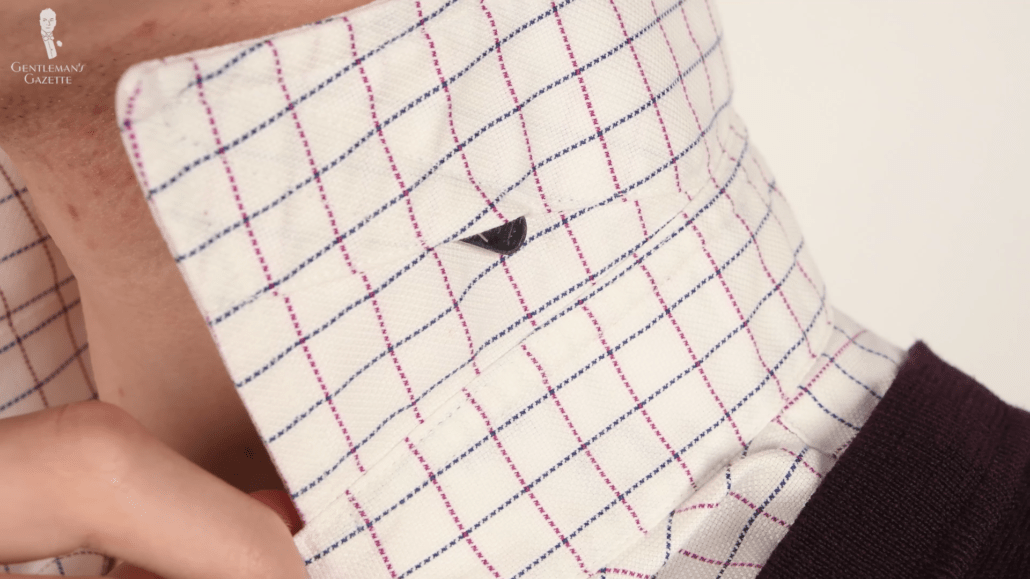
Most collar stays are removable but you may occasionally find shirts with stays that are permanently sewn into the collar. In these cases, the stays are almost always made from a thin plastic and while they’re not immediately visible, the more you launder the shirt or especially dry clean it or have it ironed, those plastic stays inside the collar will become more and more visible and they’ll eventually look unsightly over time.
There are a wide variety of collar stay styles on the market. Depending on what you’re looking for, you can find collar stays in various different lengths, widths, shapes, and materials of construction. As you might expect, choosing the correct collar stay in terms of dimensions simply means picking one out that corresponds to the dimensions of the small pocket on the underside of the shirt collar. If you own several dress shirts in a similar style, you can, therefore, continue to use the same pair of collar stays in all of those shirts thus maximizing your investment.
Collar Stay Materials
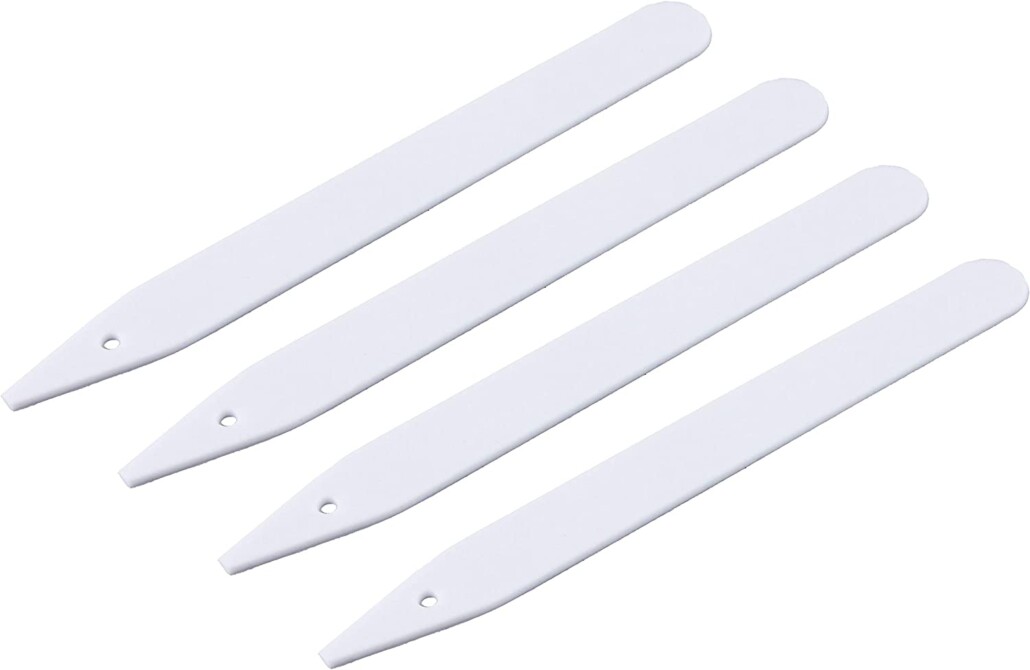
1. Plastic
Plastic is the most common material used to make collar stays simply because of its low manufacturing cost. At the same time, you do get what you pay for. While plastic collar stays may keep your collar looking crisp at first, plastic is easily bent or warped and especially if you let your plastic stays go through the wash, through the dryer, or under an iron, they’ll break down quickly and your collar will end up looking unsightly. For that reason, over plastic collar stays, we recommend a more sturdy material such as metal.
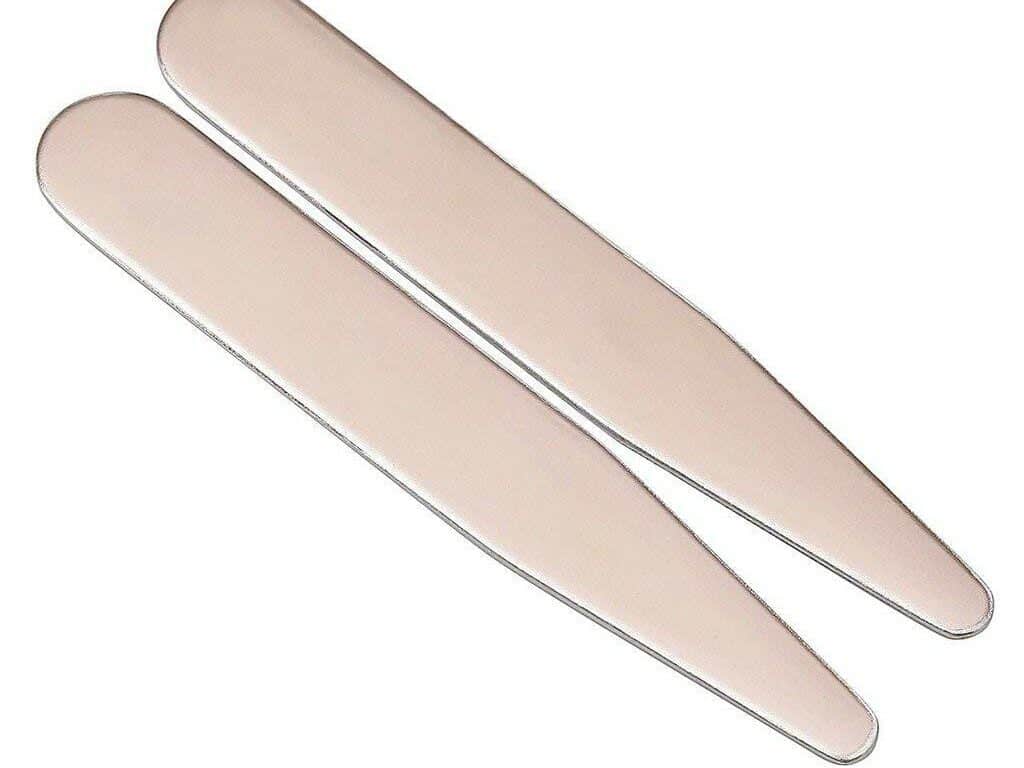
2. Stainless Steel
It’s the most common metal used in the construction of collar stays and it’s stiff and substantial so your collar will be looking crisp all day long. Cost varies depending on whether you just get simple plain stainless steel collar stays or whether you opt for more customizable features such as engraving. In which case, you would pay a little bit more. Still, stainless steel collar stays are a great investment as they’ll keep your collar looking good and they’ll last you a long time.
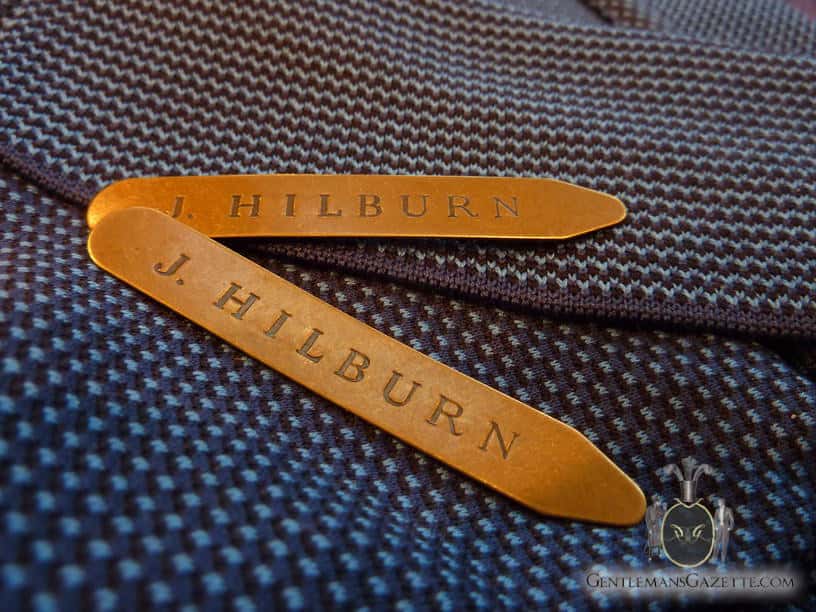
3. Brass
Functionally, brass collar stays are basically identical to stainless steel. The only difference is they can have a slightly more distinguished appearance especially if they happen to have a burnished finish. Still, because you’re the only person who’s usually going to be seeing your collar stays anyway, it’s generally not worth any additional cost to opt for brass collar stays over stainless steel ones.
4. Other Valuable Metals
As you might imagine, collar stays made from gold or other precious metals are really more of a statement piece than a practical consideration, especially considering how little anyone other than you is really going to see them. We would recommend that your money would be better spent on an accessory of a precious metal that people will actually see.
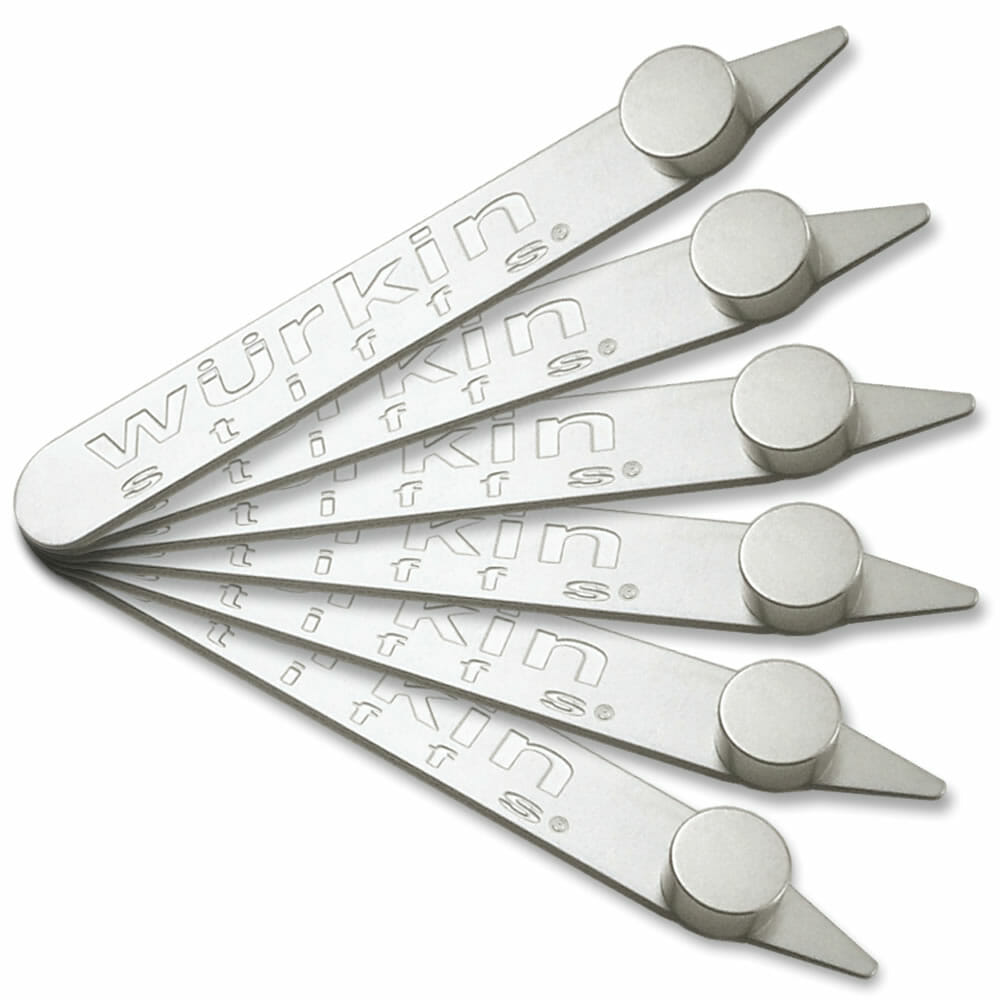
5. Magnetic Collar Stays
Some manufacturers have begun constructing collar stays out of magnetic metals and selling them as part of a package with small magnets which are then affixed under the points of the shirt collar underneath the shirt to really keep the collar secured down. While such an apparatus may ultimately keep the points of your collar down a little bit more, it’s our opinion that these types of magnetic collar stays approach the realm of gadget wear. Since ultimately, having a good fitting pair of stainless steel collar stays will provide you enough of a crisp collar without having to worry about small magnets that might get misplaced or fall off.
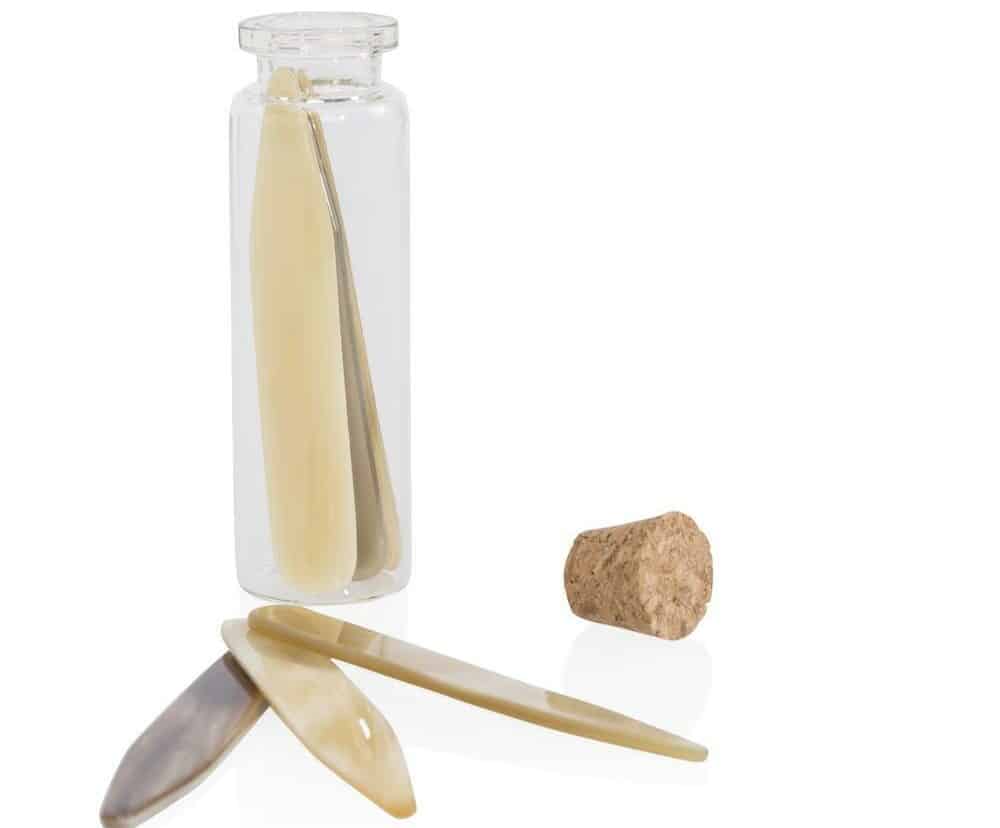
6. Exotic Substances
For example, collar stays can also be made from horn or mother-of-pearl. For the man who’s thoroughly tired of his collection of metal stays, these materials can be purchased from specialty retailers.
Collar Stay Hacks:
You can make yourself some impromptu collar stays in a pinch if the need arises. One option, for example, would be to cut up an old credit card or plastic gift card into the shape of collar stay that’s accepted by the collar that you’re wearing.
A simpler and equally effective solution, however, is simply to take two moderately sized paper clips and then use them just as you would your regular collar stays for the duration of the day. Using paper clips as collar stays is just one helpful hack that we mentioned in a recent video.
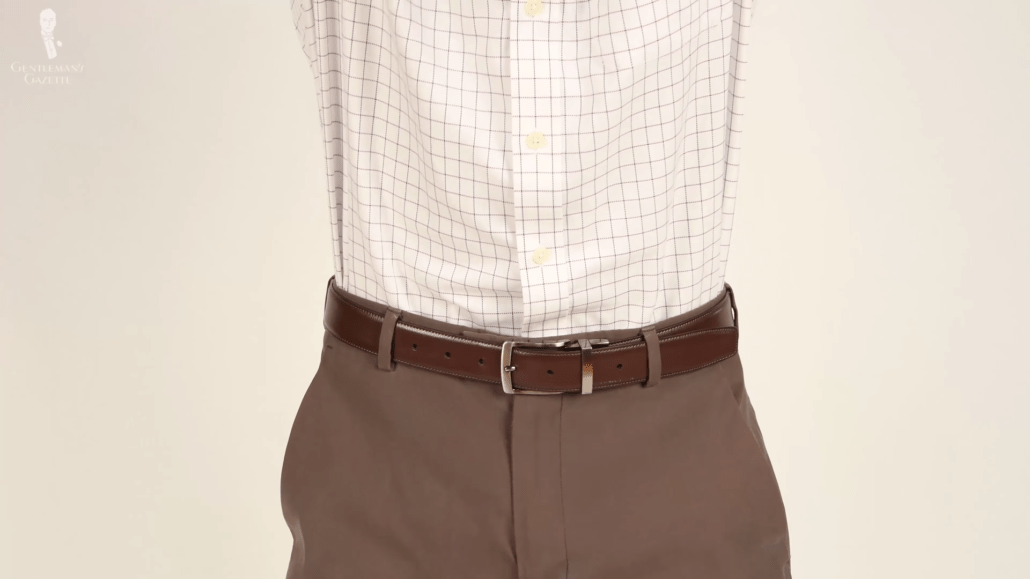
What Are Shirt Stays?
As we’ve noted many times before on this channel, fit is of the utmost importance when it comes to menswear. You may have a closet that’s full of clothing of the most luxurious materials but if it doesn’t fit you properly, you’re still going to look sloppy and not put together whatever you happen to be wearing, this is especially true for dress shirts.
If you’re wearing a shirt that’s cut too large for your frame, the excess fabric will come up over waistband more and more throughout the day leaving you with an unsightly muffin top around your waist. More modern shirt styles are cut closer to the body and therefore, they have less excess fabric but they’re still going to come untucked if parts of the shirt aren’t fitting you properly. This constant process of having to re-tuck an improperly fitting shirt can really become a nuisance quickly.
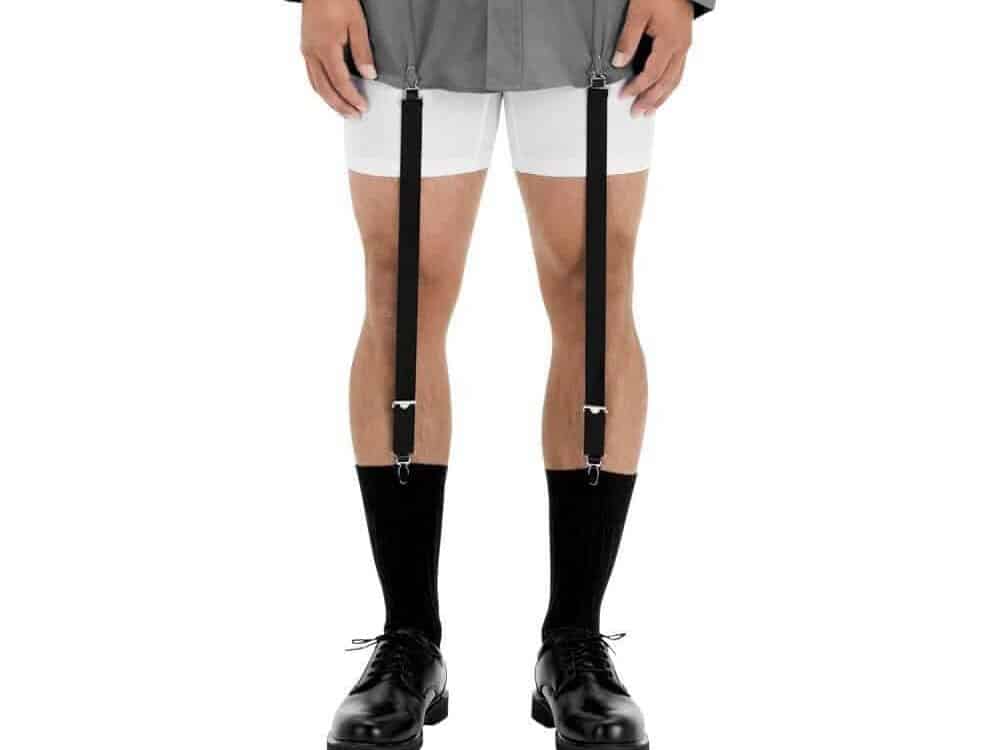
Obviously, the ideal solution would be to have a closet full of shirts that are made or indeed custom tailored to suit your frame specifically, however, if you don’t have the budget for a closet full of custom shirts or just don’t want to get rid of a few shirts that you like but don’t necessarily fit perfectly, a good temporary solution would be to use shirt stays.
Simply put, it’s a device that uses elastic tension to keep your shirt tucked in and fitting closely to your body all day. The stay attaches to your shirt tails at the top and to either your socks or around your feet at the bottom. The constant tension between these points means that you’ll be able to keep your shirt tucked in no matter how much you move just using an occasional slight adjustment, not a full re-tuck.
You may remember that we previously discussed shirt stays on our video about menswear gimmicks that you don’t need. Our founder, Sven Raphael Schneider is decidedly not a fan of shirt stays as he believes them to be uncomfortable and unnecessary. We’re discussing shirt stays today because of their place, appreciated or not, in menswear. We’re going to be ranking the styles that we believe would be better investments than some others but overall, keep in mind that the best solution to keeping your shirts tucked in is to simply buy dress shirts that fit you best in the first place.
Shirt Stay Varieties
Each one basically does the same job but in a slightly different fashion.
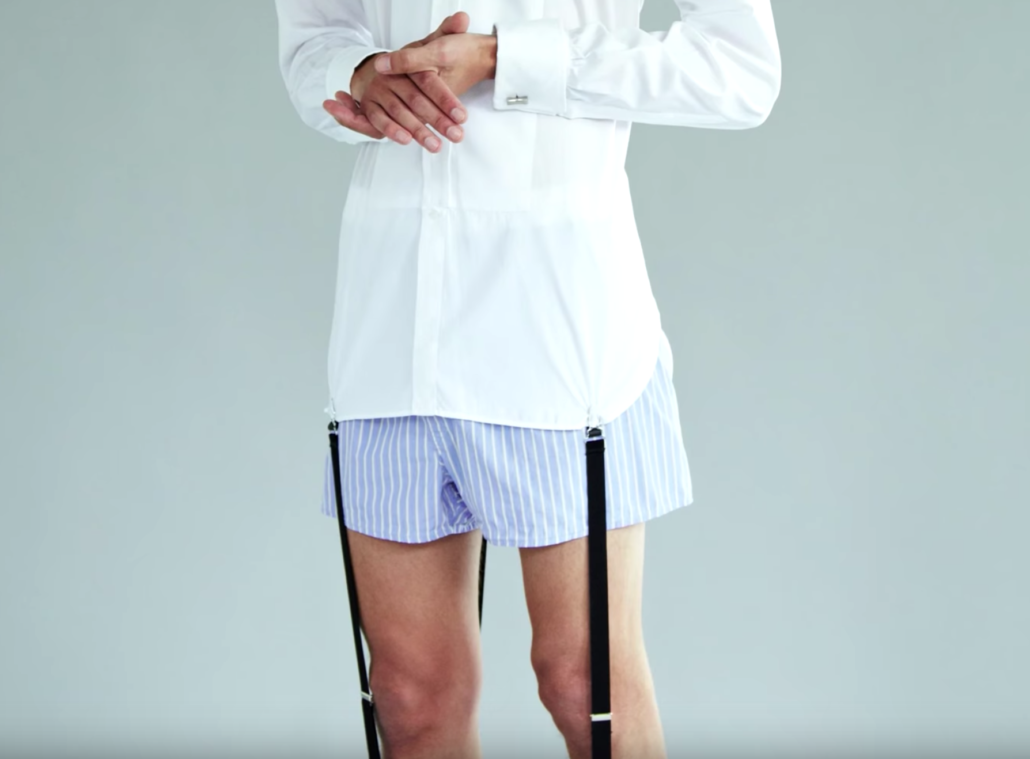
1. Straight Style
These are the most common and cheapest construction of shirt stay styles available and you’ll usually see them in packs of four. The biggest disadvantage to straight style shirt stays is their numerous connection points. With up to eight clips on the body at any given time, there’s a great likelihood that one of these clips may fail or come undone especially if the shirt stays you’re wearing happen to be of low build quality. Not only is a detached or broken clip a nuisance but if the particular shirt stay was under enough tension, there’s also a good chance that that loose clip could spring up and snap you in let’s say a sensitive area. Overall, we recommend that you stay clear of Straight style shirt stays in favor of some of the other options on this list.
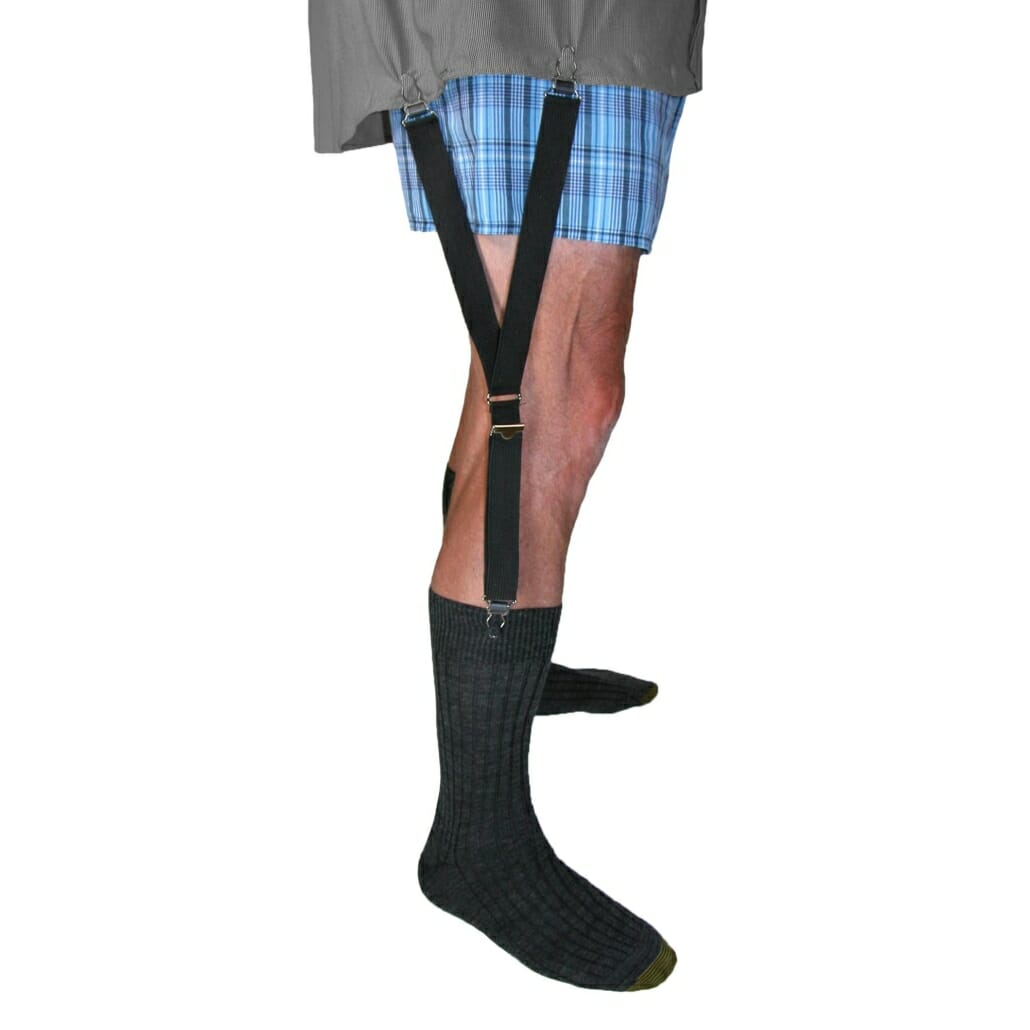
2. Y-Style
The Y style stay is constructed just how it sounds, with one clip for the socks and two clips for the shirt creating the distinctive Y shape that gives it its name. There are two big advantages of Y style stays over straight style.
The first is that there are fewer clips and ribbons to manage overall. The second advantage is that Y style stays pull the excess fabric in on top of itself at the sides of the shirt. When combined with the military tuck style of shirt tucking, this hides and smoothes excess fabric very efficiently. At the same time, there are still drawbacks to this style of shirt stays. As with the straight style, you do get what you pay for and if you’ve got stays of a low build quality, they will still degrade after a relatively short amount of time. With that said, if you are going to consider wearing shirt stays, the Y style is a particularly good choice.
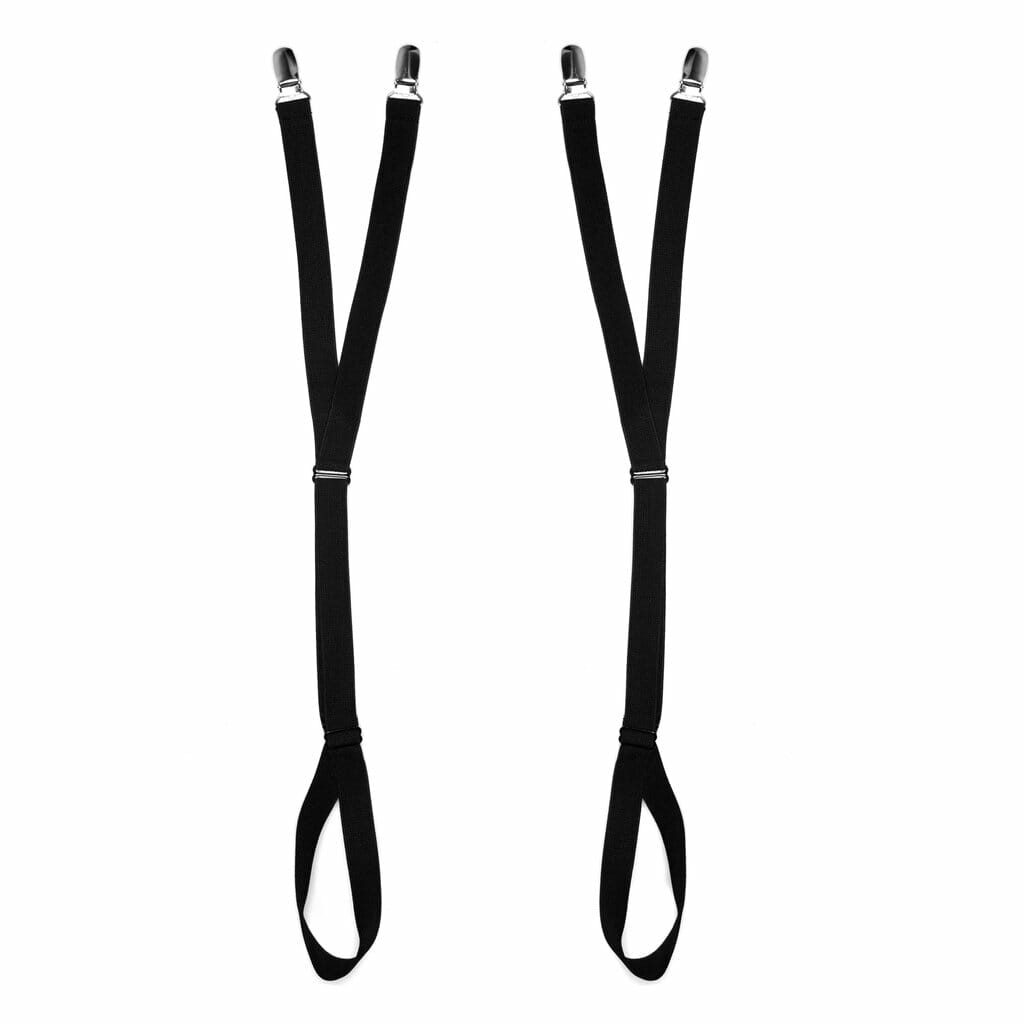
3. Stirrup Style
As the name would imply, these shirt stays have a stirrup or loop at the bottom through which the foot is inserted. This means that they only have clips where they attach to the shirttails. While this minimization of clips does provide better security for the wearer overall, the biggest downside of stirrup style stays is that they’re much more visible to other people especially when you’re sitting down and they can also be more uncomfortable to you, the wearer, because you’ve got a band of fabric surrounding your foot all day long. For these reasons, they’re best left to uniformed professionals who can sacrifice comfort for utility.
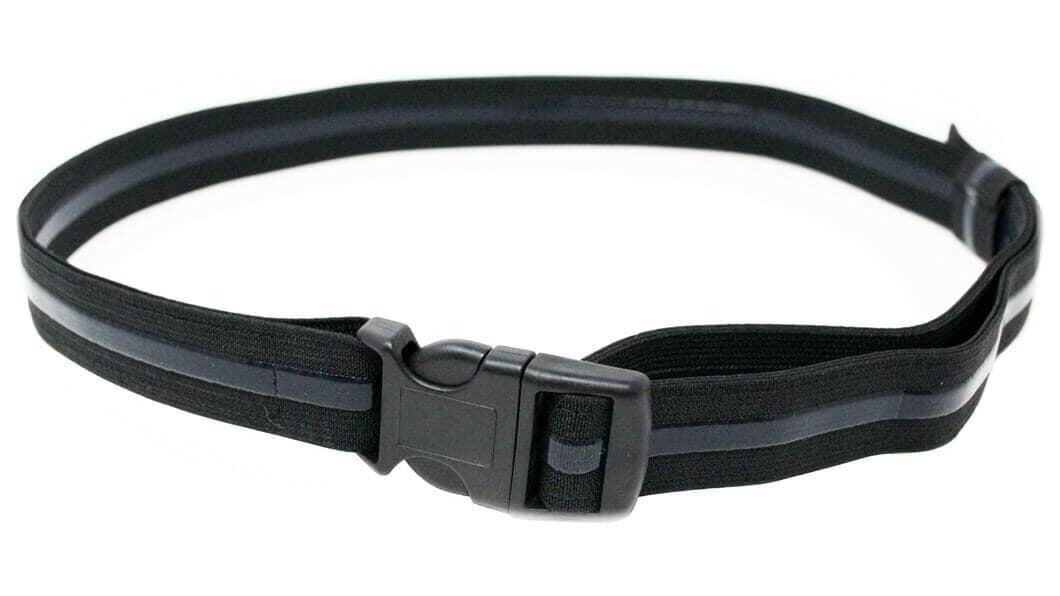
4. Shirt Stay Belt
The shirt stay belt revolutionizes the concept in that it entirely replaces vertical tension with horizontal tension around the waist. After you put on your shirt, the belt which can be made from either elasticized fabric featuring clips or from a simple piece of rubber is worn around the waist and tightened. The shirt stay belt in using horizontal tension doesn’t directly combat the vertical movement of your shirt coming untucked. Also, it doesn’t take advantage of the natural force of gravity in order to keep things secure and they’re also more likely to become visible above your waistband. We don’t recommend on the whole that you use belt style shirt stays.

5. Magnetic Shirt Stays
In recent years, rubberized plastic hemispheres with magnetic backings have been sold as a revolutionary new style of shirt stay technology. While we, here the gentleman’s Gazette, don’t have any personal first-hand experience with this style of shirt stays, reviews from other people in the menswear community have been decidedly mixed as to their effectiveness.
Speaking generally, shirt stays are an inexpensive and relatively effective way to keep your dress shirts tucked in and snug against your body throughout the course of the day. They do have their drawbacks, however, as lower build quality shirt stays models are prone to failing after only a relatively short period of use and also they’re often made from bulkier and less comfortable materials than more premium styles of shirt stays which do exist as well and may ultimately be a better investment.
CONCLUSION
At the end of the day, our recommendation is this, shirt stays should just be seen as a temporary style solution and the best course of action for any man is to invest in a wardrobe full of well-tailored dress shirts that conform specifically to his frame. In our view, collar stays are a must-have but your mileage may vary with shirt stays.
Outfit Rundown
I’m wearing both collar stays and shirt stays though you can’t obviously see them in the finished outfit. My shirt is from Charles Tyrwhitt and as such, it accepts the standard complementary brass collar stays which come with every Tyrwhitt shirt. It’s mostly simple white but it features a subtle broken check in magenta and navy. The wool cardigan is also from Charles Tyrwhitt, it’s in a color that they describe as wine and I wore it because it harmonizes with the magenta tones in the shirt. My trousers are plain brown but they’re a warm brown so they also tie in with the different red tones that I’m wearing. My socks are navy with a faint argyle pattern and of course, they echo the navy that’s featured in the outfit as well as the tie. Finishing out the bottom half of the outfit, I’m wearing my dark oxblood penny loafers, again, they’re an informal style that harmonizes with the sweater and their red-brown color harmonizes with both the trousers as well as the sweater the shirt, and the tie. Speaking of the tie, it’s a vintage design in navy silk featuring a subtle plaid pattern of both light blue and red. Finally, I am wearing cufflinks but perhaps similar to the color stays and shirt stays, they aren’t really meant to be seen with the outfit. As such, I’ve got my cuffs oriented in a barrel style and they go well with the small unobtrusive cufflinks that I’ve chosen to pull off under the sleeves of the sweater.
Do you use either of these menswear accessories and if so, what are your thoughts on and experiences with them?
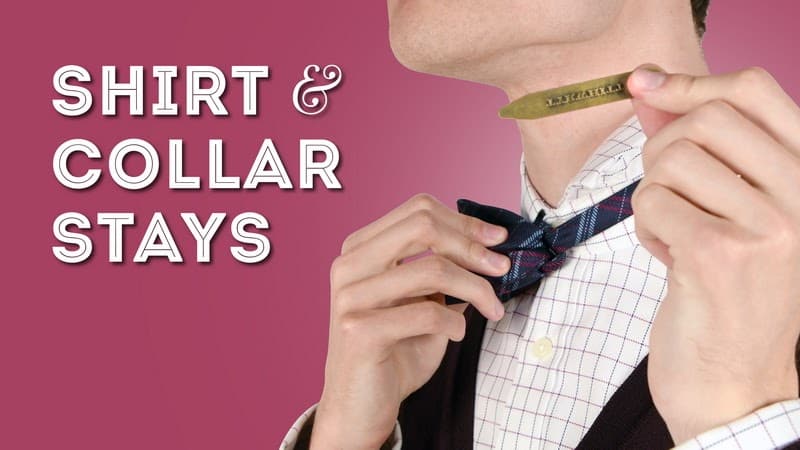

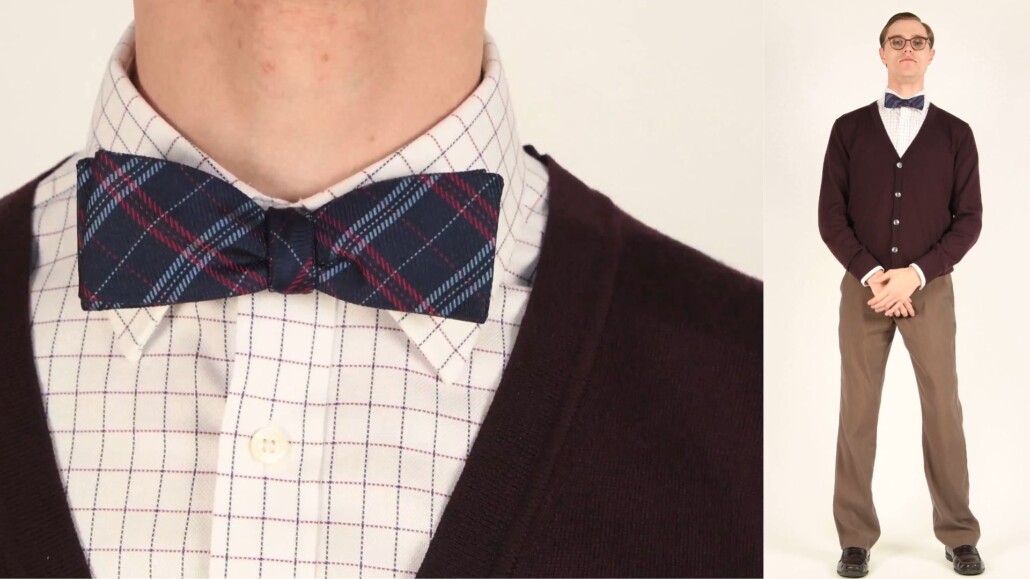
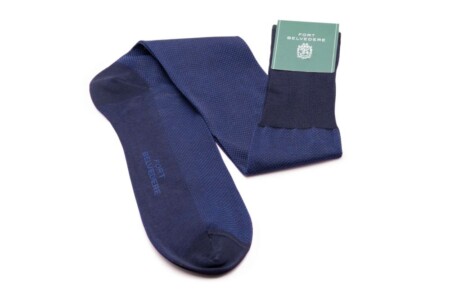
I can say that this website has helped me a lot in becoming more comfortable and knowledge about men’s fashion. Thank you very much. With that being said, I always use a collar stay in my dress shirts for work. They are a “hidden” secret to many men and I feel it is now my “duty” to pass on the knowledge learned here, to my fellow males!!!
It is our pleasure. Thank you for the comment. :)
I use a completely different tactic. I order my shirts from my online tailor with hidden button collars. They stay in place no matter what and the collars always stand up when the shirt is unbuttoned. None of that saggy-placket thing going on.
Always collar stays. NEVER shirt stays!
I get free brass collar stays in each of my shirts from Charles Thywritt. They a are far superior. Sores are always welcomed by my colleagues.
I always called them whale bones though. No idea why.
I use stainless or brass collar stays.
Never needed to use shirt stays. I use suspenders and tailored shirts, rarely have issues with them pulling up.
Collar Stays and Sock Suspenders always . Simply set and forget .
They also enhance comfort and stop a lot of fidgeting .
Brass collar stays are great. The “shirt stays braces” should be banned for life. The rubber “grippie strip” on the inside of trousers is a much better solution. J Hilburn is the Herbalife of men’s ware and should be avoided at all cost.
Does anyone in the real world actually use shirt stays? They look awful…
Simon,
No one sees them except you and they really aren’t that bad. I wouldn’t generally recommend them except for really formal occasions where you don’t want to look sloppy halfway through the day. I wore them in the military with full dress uniform and they worked quite nicely. I prefer the sewn in grip strip which works quite nicely and is more comfortable, although definitely still not as sharp as the stays.
I bought a set of stainless collar stays and use them every day. They came in different lengths so I just pick out the pair that fits the shirt I’m wearing. The biggest problem that I have seen so far is that the points have pushed through the fabric on a couple shirts. One I was able to hem because it tore through the seam, the other is underneath and probably not repairable. I could see the bone ones being less sharp and therefore less problematic. That being said, took a lot of wearing before it happened so it hasn’t been the hugest issue.
I use both collar stays and shirt stays. I wear Charles Tyrwhitt shirts almost exclusively, so my valet box is full of brass stays in several lengths. What I like about brass over steel is that they can be given a slight arch by bending over a soup can. This arch can give a spread collar an extra bit of character, especially when worn with a Windsor knot. I will disagree on magnetic collar stays being gadgets. I do not like the appearance of button-down collars at all, so when I’m wearing an open collar with a v-neck sweater or waistcoat, I use magnetic stays to prevent me from looking like John Travolta in Saturday Night Fever.
In regards to shirt stays, I have most of my trousers MTM, and I have full internal rubber bands sewn into the waist bands. I find these work perfectly. For other trousers, I use the shirt stays with the elastic bad that wraps right above the knees. I wear knee-high socks, so the sock-clip versions just don’t work. I have an exaggerated V-taper as a physique competitor, so every article of clothing I have goes to the tailor. But, even a perfectly tailored shirt will eventually work loose during the up and downs of an office job. I like my shirts to be tightly tucked, so shirt stays are a must.
Thanks for sharing!
Dear Messrs.,
Always enjoy the variety and depth of your content. If I may make one point for enhancement, I noticed the article did not mention rear shirt stays, i.e. buy 4, 2 go in front and two in rear. The mil has been doing this for years. However “too tight” is the norm and the 99% of us with them can’t really hide our love handles with this. It’s nice to have an inch of give all around but still remain snappy (which the stays will do if you aren’t cautious). Another downside is they can rub off your leg hair with daily use.
I have some slacks that have a couple of small rubberized pieces of material around the inside of the waistband that seem to be there to keep shirts from tucking out. Maybe they can be sewn on to other pants. Seems to work for me.
I wear stainless steel coller stays which are very good. I also have socks shirt stays and stirrup shirt stays. I wear stirrup stays inside the socks which works better and I think they are better than socks ones.
I have found that metal collar stays invariably tear through the collar fabric at the tip after not too many uses (the tip rubs against the wearer’s neck). Heavier plastic ones are excellent and accompany shirts from many better stores (e,g, Brooks, Stuart). They can also be bent a bit to provide a bit of curve if one wants.
Omitted from the discussion is the convenient loop that is found on better formal shirts that fasten about a button inside the wasteband of dress trousers. Similar loops and buttons can easily be added to any shirt or trouser.
What about shirt stays for white tie events? Is there another way to keep a pique shirt completely flat during an entire evening?